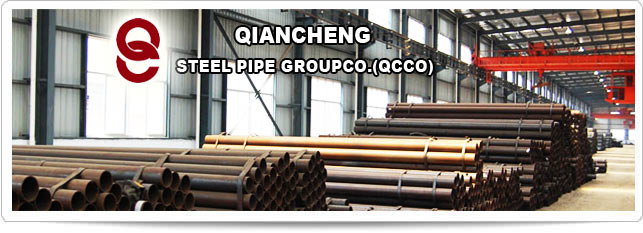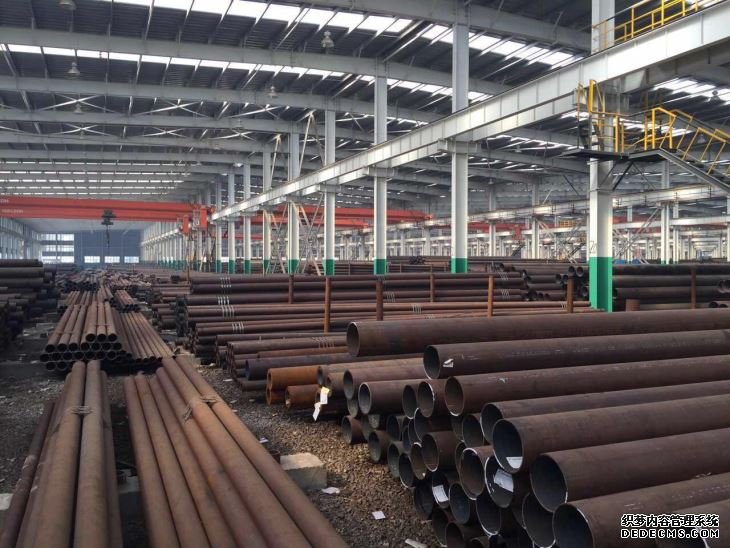EN10216 steel pipe technical parameter
Home >
-
API steel pipe
- API steel pipe
- API steel casing pipe
- Casing and Tubing
- API drill pipe
- API5L steel pipe
- Oil pipeline

-
Carbon steel pipe
- Carbon steel pipe
- Welded steel Pipe
- seamless carbon steel pipe
- Petroleum Casing Pipe

-
Alloy steel pipe
- astm a 335 gr p22
- alloy steel pipe l555
- 25crmo4 alloy steel pipe
- alloy pipe a335 p11








- Applications of welded pipe pil
- welded steel pipes and Seamless
- ASTM A 106 Seamless Pipe
- seamless steel pipe production
- What is API Standards For Line
- seamless steel pipe On-line col
- EN 10305-1 / DIN 2391 cold draw
- EN 10255 Standard Pipe,replaces
- API 5L A53 / A106 Grade B, Seam
- A178 ERW STEEL PIPE, SA178 CARB

One of the Top 500 enterprises in China foreign trade
QCCO was approved as a member of “China Association for Contracting Projects Abroad “and granted a membership certificate on Sep 28,2005; “Credibility Rating AAA certificate in Foreign Trade” was granted to QCCO by China Shippers’ Association

6.2 Options The number of options in this section of EN10216 is listed in the following table.
When the purchaser does not want to point out any of the following options when he or she orders, the technical delivery conditions are in accordance with the basic requirements (see 6.1).
1. Steelmaking process requirements (see 7.1)
2. Requirements for delivery conditions (see 7.2.4)
Specified range requirements for 3.S content (see table 2, pin b)
4. Product analysis (see 8.2.2)
5. Additional mechanical properties test, special heat treatment is required for the specimen (see 8.3.1)
6. Room temperature Impact test
7. Whether the austenitic corrosion-resistant steel pipe with a wall thickness exceeding 60mm is subjected to the normal temperature mechanical properties test (see table 6, foot mark a)
8. The requirement for mechanical properties test of austenitic creep steel pipe with wall thickness exceeding 50mm (see table 7, pin a)
9. Verify the requirements of high-temperature Rp0.2 or Rp1.0
10. For the wall thickness of more than 60mm austenitic corrosion resistant steel pipe to the high temperature strength of the requirements (see table 9, foot mark a)
11. Low temperature impact test (see 8.3.3)
12. Intergranular corrosion test (see 8.4)
13. Selection of permeability test methods (see 8.5.2.1)
14. OD ≤101.6mm and wall thickness ≤5.6mm, test type TC2 tubing, longitudinal integrity nondestructive testing (see 8.5.2.2).
15. Non-destructive testing of transverse integrity for TC2 tubing 16.TC2, a specific wall thickness of more than 40mm pipe, at the end of the pipe (layer inspection?)
(see 8.5.2.2).
17. Special pipe-end treatment (see 8.7)
18. Fine determination ruler (see 8.8.3)
19. For tubing with OD ≥219.1mm, Tube end size (see table 12)
20. Cold-machined tubing adopts d4/t4 tolerance grade (see table 13)
21. In addition to the standard inspection documents, other inspection documents (see 9.2.1)
22. Pressure Requirements for hydrostatic test (see 11.6.1)
23. Away from the end of the wall thickness test (see 11.7)
24. Additional code (see 12.2)
25. Special protection measures (see 13)

6.3 Order Samples
6.3.1 Sample 1
2000 m hot-working seamless pipe, outside diameter 168.3, wall thickness 4.5mm, standard en10216-5, tolerance class d2/t2, steel grade X2CRNI19-11,TC1,3.1B Quality Assurance Book (EN10204):
2000M-HFD TUBE-168.3X4.5-EN10216-5-X2CRNI19-11-TC1
6.3.2 Sample 2 300 m cold processing seamless pipe, outside diameter 42.4mm, wall thickness 2.6mm, standard: en10216-5, tolerance grade D3/t3, Grade: 1.4301, test Type: TC2, intergranular corrosion test: EN ISO 3651-2-a, verify 300 ℃ elastic limit strength,
Non-integrity of longitudinal and transverse nondestructive testing, Warranty: 3.2 (EN10204)
7. Production process
7.1 Steelmaking Process
The steelmaking process is determined by the manufacturer itself, but see option 1
Option 1: The steelmaking process used should be made known to the purchaser and marked on the inspection report.
7.2 Pipe manufacturing process and technical delivery conditions 7.2.1 All NDT tests must be performed by a qualified and capable 1, 2, or 3 employee authorized by the employer.
Qualification should be based on EN10256, or at least a specification equivalent to it. Recommendation 3 employees should be trained in accordance with EN473 or at least one of the specifications equivalent to it. The operation authorization should be issued by the employer in written form.
The operation of the NDT test must be authorized by the employer before it can be practiced by 3 workers.
Note: 1, etc., 2, etc., 3 definitions can be found in the appropriate standards, such as: EN473 and EN10256 inside 7.2.2 Tubing in accordance with the seamless pipe process production, thermal processing or cold processing.
The so-called "hot processing" "Cold processing" refers to the process of heat treatment before, see 7.2.3 production process is determined by the manufacturer, but see option 2
The delivery state of 7.2.3 pipe should be solid solution (annealing), there are two kinds of cases;
--Reference heat treatment state -Direct solution annealing and then cooling in extrusion to ensure mechanical properties, corrosion resistance and other properties required by en10216-5.
All mechanical properties should meet the requirements after indirect annealing. Solution Treatment: The tube is uniformly heated to a certain temperature and then cooled rapidly.
The heating temperature of each different brand refer to table 6,7,8.
8.3 Mechanical Properties
8.3.1 Room temperature
The mechanical properties of the tubing at room temperature should be in accordance with the requirements in form 6,7,8 and clause 11. In case of unconventional heat treatment or additional heat treatment (which the purchaser should indicate in the enquiry and order), additional mechanical performance test samples will be performed, which are indicated in form 6,7 and 8.
The heat treatment and mechanical properties of the sample shall be agreed by the manufacturer and purchaser and shall be indicated in the inquiry and order.
Option 5: Special or additional heat treatment of the sample, the need for additional mechanical properties test.
8.3.2 High Temperature
8.3.2.1 yield Strength
Tables 9,10 and 11 list the values of minimum yield strength Rp0.2 and Rp1.0 at elevated temperatures
Option 9: Yield strength Rp0.2 and Rp1.0 should be verified (for dual phase steel, just check Rp0.2), the test temperature should be indicated in the inquiry and order.
8.3.2.2 Creep rupture strength
The initial average of creep rupture strength is given in Annex A.
Note: The steel number not mentioned in table A.1 is not suitable for creep range.
8.3.2 Low Temperature The value of the impact work at a given temperature should be consistent with the values given in table 6 and 8.
Option 11: Perform a low-temperature impact test.
8.4 intergranular Corrosion The information of intergranular corrosion resistance of 6,7 and 8 is given in the table.
The intergranular corrosion test is conducted in accordance with EN ISO 3651-2, in which three methods of measuring intergranular corrosion are given: A, B and C.
The guidance values of the limiting sensitivity temperature for intergranular corrosion are listed in table 9,10 and 11.
Option 12: Test for resistance to intergranular corrosion of materials
If there is a special test for intergranular corrosion, these tests should be indicated in the inquiry and order.
8.5 apparent
8.5.1 View of the table
The inner and outer surfaces of the 8.5.1.1 pipe are not allowed to have surface defects visible to the naked eye. The internal and external surfaces of the 8.5.1.2 pipe should be able to represent the manufacturing process of the manufacturer, and heat treatment can be performed where applicable. In general, this should be the case for processing methods and surface conditions-and any
上一篇:16Mn seamless steel pipe Stock,Structural,fluid,thick-walled


